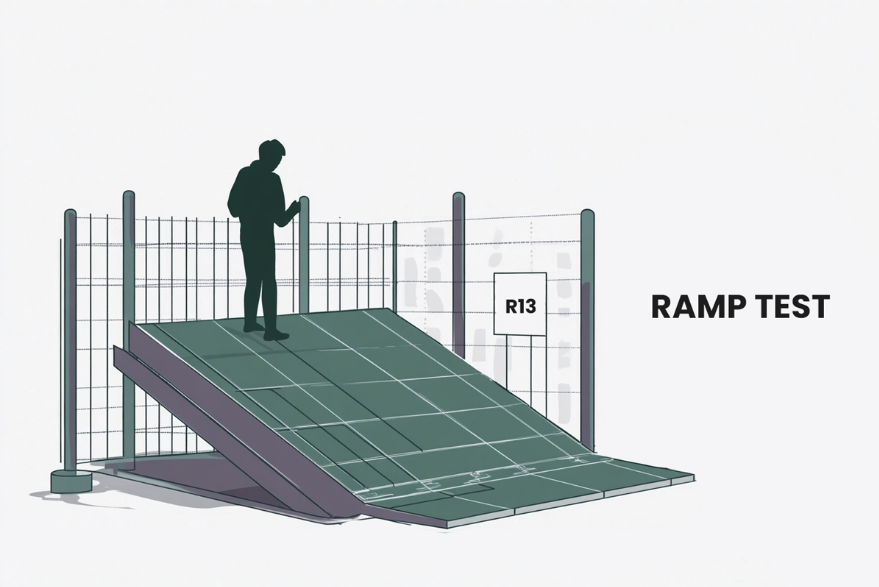When you’re choosing tiles, one of the biggest concerns is safety. You don’t want to end up with slippery floors, especially in places where water or moisture might be common, like kitchens, bathrooms, or patios. You might be wondering, “What’s the best way to make sure my tiles are safe?” This is where anti-slip ratings come into play.
But understanding these ratings can be tricky. What do terms like R9, R10, or R11 really mean? How do they help you decide which tiles are right for your space? Whether you’re thinking about installing tiles indoors or outdoors, this article will explain everything you need to know about anti-slip ratings.
Table of contents:
- What is an Anti-Slip Rating and Why It Matters
- R9 Anti-Slip Rating
- R10 Anti-Slip Rating
- R11 Anti-Slip Rating
- R12 and R13 Anti-Slip Ratings
- Choosing the Right Anti-Slip Rating for Your Space
What is an Anti-Slip Rating and Why It Matters
Anti-slip ratings are a way to measure how slippery a tile is. These ratings help you figure out if a tile will give you enough grip to walk on safely, especially in areas where slipping is a concern. The ratings are given using the “R” system, which stands for “ramp test.” The higher the number after the “R,” the more slip-resistant the tile is.
Why does this matter? Well, not all tiles are the same, and the amount of slip resistance you need depends on the environment. In a dry hallway, you might not need a tile with a high slip rating. But in a bathroom or on a patio where the floor can get wet, you need tiles that will prevent you from falling. Another case where you might need to consider a higher slip rating for the tile is the kitchen or commercial space.
The R rating system ranges from R9 to R13. R9 is the lowest slip resistance and is suitable for dry areas, while R13 is the highest and works well in very wet environments like showers or pool areas. Choosing the right rating is essential for keeping your space safe and practical. Understanding these anti-slip ratings will help you choose the best tile for your needs, whether you’re tiling a home or a commercial space.

How Anti-Slip Ratings Are Tested
As we mentioned previously, the anti-slip ratings are determined through a test called the “ramp test.” This test is used to figure out how much grip a tile provides in different conditions, like when the surface is dry, wet, or even oily. The test is performed by placing the tile on a ramp and increasing the angle of the ramp until a person standing on it starts to slip. The angle at which slipping occurs gives the tile its R rating.
For example, an R9 rating means the tile begins to become slippery at a lower angle, making it suitable for dry areas. On the other hand, an R11 slip rating or higher means the tile can handle steeper angles without losing grip, making it ideal for areas where the floor might get wet or oily, like bathrooms or outdoor spaces.
The “inclination plane” is the term used to describe the angle of the ramp during the test. The higher the inclination, the more slip-resistant the tile is. This simple test helps you understand how well the tile will perform in real-world conditions, whether it’s in your home or a high-traffic commercial space. By knowing the anti-slip rating of a tile, you can make sure you’re choosing a safe option that fits your needs.
Now, let’s take a closer look at each slip-rating.
R9 Anti-Slip Rating
R9 tiles have the lowest level of slip resistance in the R rating system. These tiles are best suited for areas that stay dry most of the time. Because of their lower grip, R9 tiles are ideal for spaces like entranceways, dry hallways, and other indoor areas that don’t typically get wet.
If you’re thinking about using R9 tiles in places like kitchens or bathrooms, you might want to reconsider. These areas can sometimes get wet, and R9 tiles may not provide enough traction to keep you or your family safe.
One common question is whether an R9-rated tile is suitable for a patio. In most cases, R9 tiles are not the best choice for outdoor use, especially in places that might be exposed to rain or other moisture. Since patios can get wet, you need a tile with higher slip resistance to prevent accidents. While R9 tiles are great for dry indoor spaces, you’ll want to look for a tile with a higher rating, like R10 or R11, for outdoor areas.
R10 Anti-Slip Rating
R10 tiles offer a moderate level of slip resistance, making them a good option for spaces that sometimes get wet but aren’t constantly exposed to moisture. These tiles are often used in kitchens, utility rooms, and other areas where occasional spills or dampness might occur.
Because R10 tiles provide better grip than R9, they are a safer choice for areas with light traffic where spills might happen from time to time. For example, if you have a kitchen where cooking and cleaning may cause wet floors now and then, an R10 slip rating will give you added peace of mind without being too difficult to clean.
While R10 tiles aren’t typically used in high-traffic or very wet areas, they strike a good balance for indoor spaces that need moderate slip resistance. So, if you’re looking for a safe and practical solution for areas like kitchens or laundry rooms, an R10 slip rating might be just what you need.
R11 Anti-Slip Rating
R11 tiles are a highly slip-resistant option, making them ideal for both wet and dry environments. Whether you’re installing tiles in a bathroom, kitchen, or even an outdoor patio, R11 tiles provide the grip you need to prevent slipping, even in areas where water is present.
One of the key advantages of R11 tiles is their versatility. They can handle both indoor and outdoor conditions, making them a great choice for spaces that experience a mix of weather or moisture. For example, if you’re tiling an outdoor patio that gets wet from rain or a bathroom where floors are often damp, an R11 anti slip rating ensures that you’re prioritizing safety without sacrificing style.
R11 tiles are also known for their durability, which makes them suitable for high-traffic areas. Whether it’s a busy kitchen or a frequently used outdoor space, these tiles hold up well over time while providing excellent slip resistance. With an R11 anti-slip rating, you can be confident that these tiles will perform well in spaces where safety and durability are key concerns.
R12 and R13 Anti-Slip Ratings
R12 and R13 tiles offer the highest levels of slip resistance, making them the safest choice for very wet environments. These tiles are typically used in areas where water is constantly present, such as around pools, in commercial kitchens, or in public showers. Their excellent grip helps prevent accidents in places where slipping could be a significant risk.
For high-risk settings, R12 and R13 tiles provide the necessary safety to ensure people can move around without fear of slipping, even in extremely wet conditions. Whether it’s an industrial kitchen where spills are common or a poolside area where wet floors are unavoidable, tiles with these anti-slip ratings are specifically designed to handle these environments.
In commercial or industrial settings, where safety regulations are strict and the risk of accidents is higher, R12 and R13 tiles are essential. Their superior grip and durability make them a practical choice for ensuring the safety of employees and customers alike. While they may require more maintenance due to their rougher texture, the safety benefits of these tiles are unmatched.
Choosing the Right Anti-Slip Rating for Your Space
Choosing the right anti-slip tile for your space depends on two main factors: the amount of moisture in the area and how much foot traffic it gets. Different rooms and environments require different levels of slip resistance, so understanding the specific conditions of your space will help you make the best decision.
To make it clearer and easier to understand what exactly you should be looking for we have prepared a table that matches the conditions and the anti-slip rating.
| Conditions | Recommended R-rating |
| Dry indoor areas (e.g., hallways) | R9 |
| Occasional wet areas (e.g., kitchens, utility rooms) | R10 |
| Wet indoor areas (e.g., bathrooms) | R11 |
| Outdoor patios (wet conditions) | R11 |
| Commercial kitchens or high-traffic wet areas | R12, R13 |
| Pool areas, industrial settings | R12, R13 |
Final Thoughts
When it comes to choosing the right tiles, safety should always be a top priority. The R rating system helps you make an informed decision by showing you which tiles offer the right amount of slip resistance for different spaces. Whether you’re working on a simple home renovation or managing a commercial project, understanding these anti-slip ratings ensures that you choose tiles that are not only stylish but also practical and safe.
Take the time to think about where you’ll be using these tiles and how often the floors will be exposed to water. By choosing the right anti-slip rating, you can avoid accidents and enjoy a safer, more secure space.
If you’re ready to choose the perfect tiles for your home or business, explore our full collection of R-rated tiles. Feel free to reach out if you have any questions or need more advice — we’re here to help!

